Monthly economic brief: October 2020
The monthly economic brief provides a summary of latest key economic statistics, forecasts and analysis on the Scottish economy.
This document is part of a collection
Business Activity
Business activity continued to stabilise into the third quarter of the year, however subdued demand, heightened uncertainty and new local restrictions have weighed on the pace and scale of activity.
Proportion of business trading
- National lockdown restrictions required many businesses to close or scale down activity in March. The easing of national restrictions into the third quarter enabled businesses to gradually reopen, and by the start of October, the proportion of business reporting as currently trading had risen to 97%.
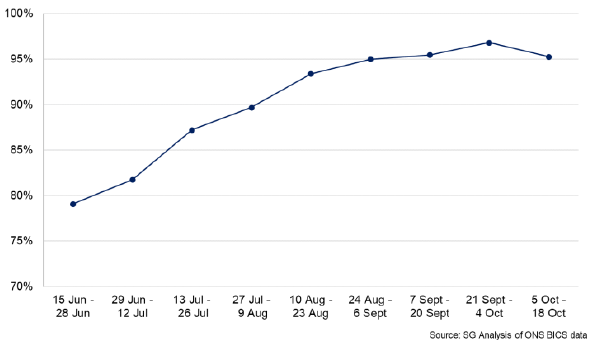
- Latest data into the first half of October showed that the proportion of businesses currently trading had eased back slightly to 95% with the Accommodation and Food Services sector (80%) and the Arts, Entertainment & Recreation sector (89%) continuing to have the lowest proportions trading and decreasing over the latest period.[2]
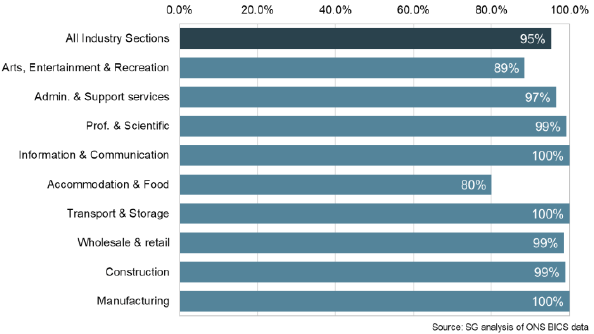
Interim Evaluation of COVID-19 Business Support Measures in Scotland
Given the pace and scale of the collapse in economic activity as a result of the COVID-19 pandemic, the Scottish and UK Governments introduced a significant package of business support measures aimed at helping businesses survive and maintain employment through the crisis.
The Office of the Chief Economic Adviser (OCEA) has been undertaking an ongoing programme of work to evaluate the impact of the support available to businesses in Scotland. The first stage of this work considers the outputs of the schemes (in terms of numbers of businesses and jobs supported) and early outcomes (in terms of the extent to which the measures introduced have helped businesses survive through the immediate crisis) to guide ongoing policy thinking on business support as the COVID-19 situation changes. It draws on scheme management information data, ONS’ Business Impacts of Coronavirus Survey (BICS), qualitative evidence from business representative organisations and OCEA’s sectoral viability model, which explores business viability (turnover, cashflow, profitability and employment) across the sectors of the economy.
The key results of this first stage of the evaluation are set out below which highlight the important role that Government support has played in helping businesses survive.
Estimates of Application and Take-up Rates by Scottish Businesses
- 14% of Scottish businesses did not apply for any support.
- 38% of small to medium-sized enterprises applied for Scottish Government grants, in line with the targeting of these schemes (2% of large firms applied).
- 20% of Scottish businesses received SG Business Support Fund Grants; 7% SG Pivotal Enterprise Resilience Fund; 7% SG sector-specific grants.
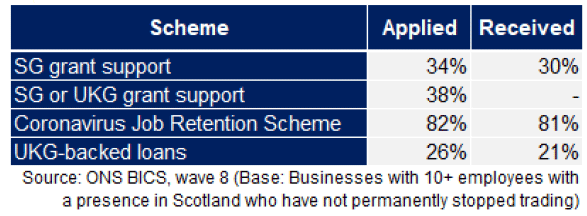
Overview of Impact of Business Support
- 71% of businesses in Scotland who received support reported that it had helped them to continue trading.
- 88% of those who received SG support[3] felt it helped them continue trading compared to those that received UKG support only (65%).
- This suggests that the support provided by SG had an ‘additional’, complementary impact, over and above that of UKG schemes.
- Business organisations’ feedback echoed this, with SG support filling key gaps, though for a limited number of firms/ sectors.
- OCEA sector viability modelling suggests the sectors finding the support most helpful were among the most adversely affected by the crisis.
- Business feedback and OCEA Modelling suggests that support is effective in softening the impacts of the pandemic, and is significant in supporting Accommodation & Food Services, and Arts, Entertainment & Recreation sectors in particular.
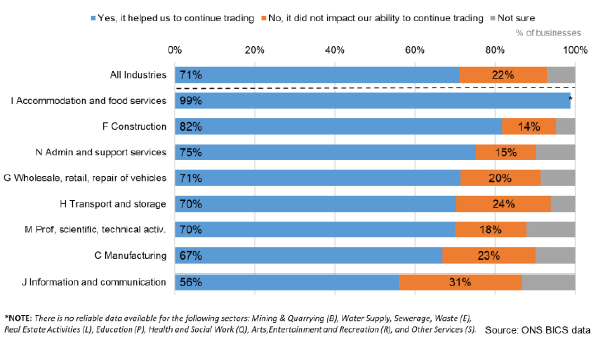
Business activity
- The RBS Purchasing Managers Index (PMI)[4] showed an increase in business activity in Scotland for the second consecutive month in September (51.2).[5] However, the pace of growth was mild and notably slower than in August (55.8), reflecting a fall in new business over the month.
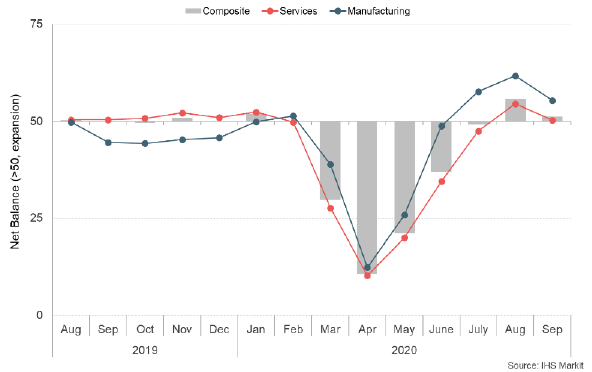
- At a sector level, growth in business activity continued to be stronger in the manufacturing sector (55.3) while service sector growth was more marginal (50.3).
- The easing in business activity growth was linked to a combination of subdued client demand and heightened uncertainty. This was also reflected in a decrease in business optimism for the coming 12 months which fell to its lowest level since May.
- The more recent UK Flash PMI for October signalled further growth in UK business activity over the month, however at a notably slower pace than in September and driven by a fall in new business volumes. This was most pronounced in the services sector which respondents linked with tighter local restrictions impacting on consumer activity as contributing factors.[6]
Trade
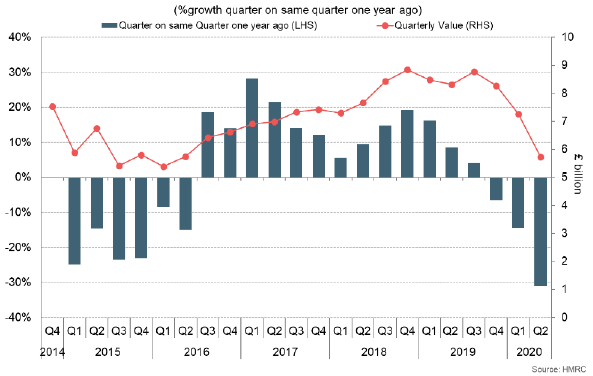
- On the back of significant global trade headwinds in 2019 and Brexit uncertainty, many businesses faced further challenges to trade in the first half of 2020 due to the pandemic and lockdown measures impacting supply chains and demand across countries.
- In Q2 2020, the value of Scotland’s goods exports was £5.7 billion, a decrease of 31.1% compared to Q2 2019 (UK: 28.7%). The fall in exports over the year was driven by a fall in oil & gas exports (-52.4%) and a fall in beverages exports (-39.9%).[7]
- Latest data on Scottish ports activity (non-EU trade only) up to August 2020 shows further evidence of subdued trade activity. In August, the value of non-EU exports leaving Scottish ports (£433 million) was down 50% compared with August 2019 and the value of non-EU imports entering Scottish ports (£448 million) was down 55% over the year.[8]
- Scottish Government estimates of ONS data[9] suggests that subdued trade activity continued further into the start of the fourth quarter with 46% of Scottish trading exporters reporting that they were exporting less than normal and 35% of Scottish importers.
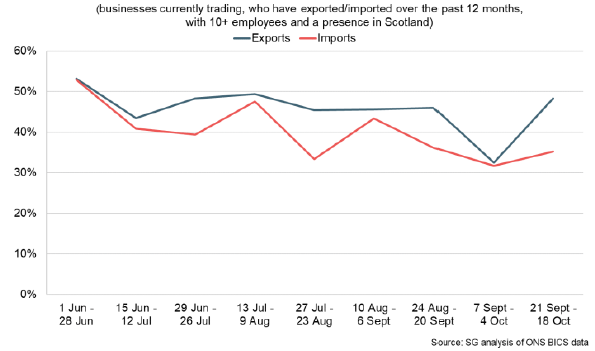
Contact
Email: OCEABusiness@gov.scot
There is a problem
Thanks for your feedback